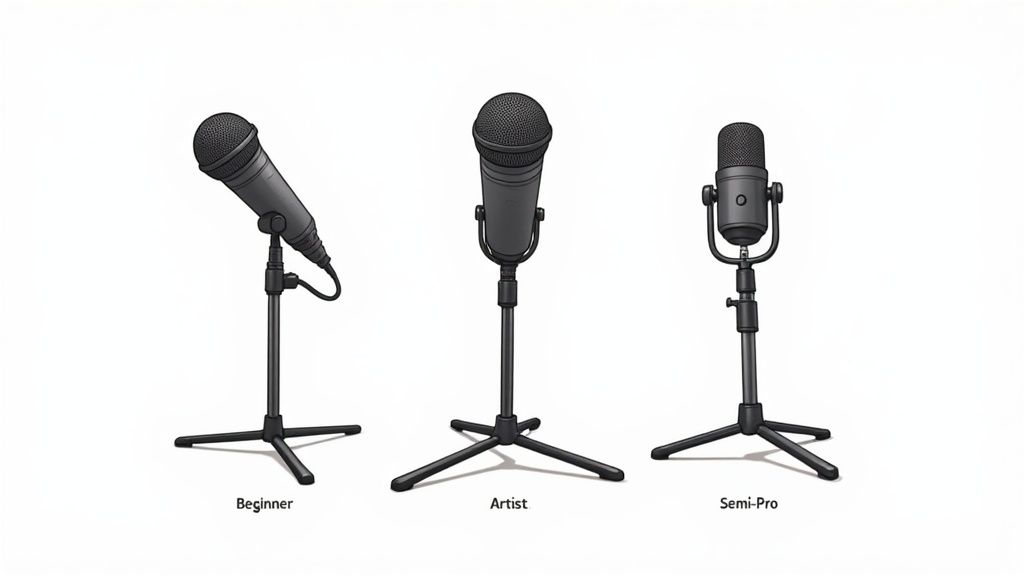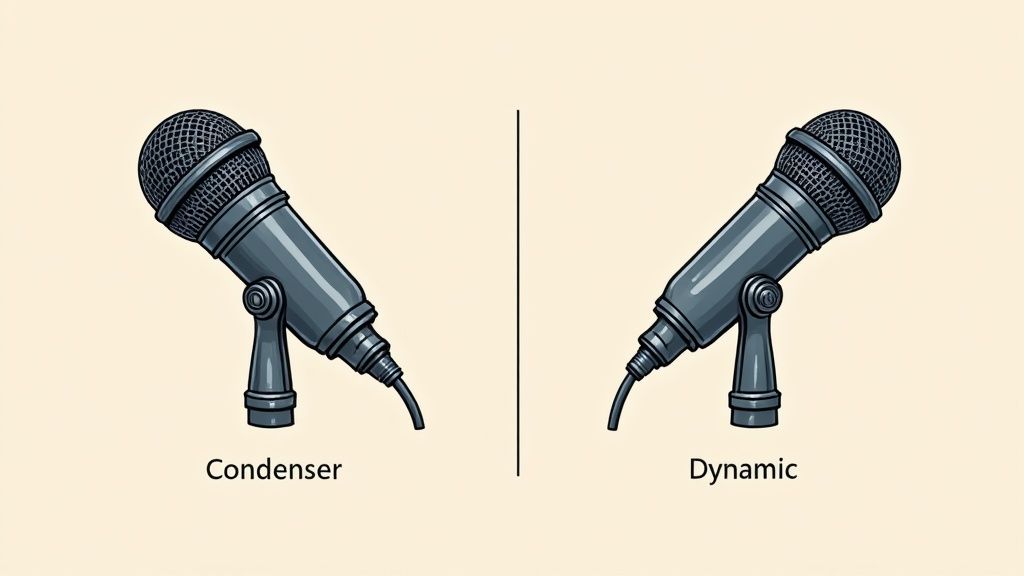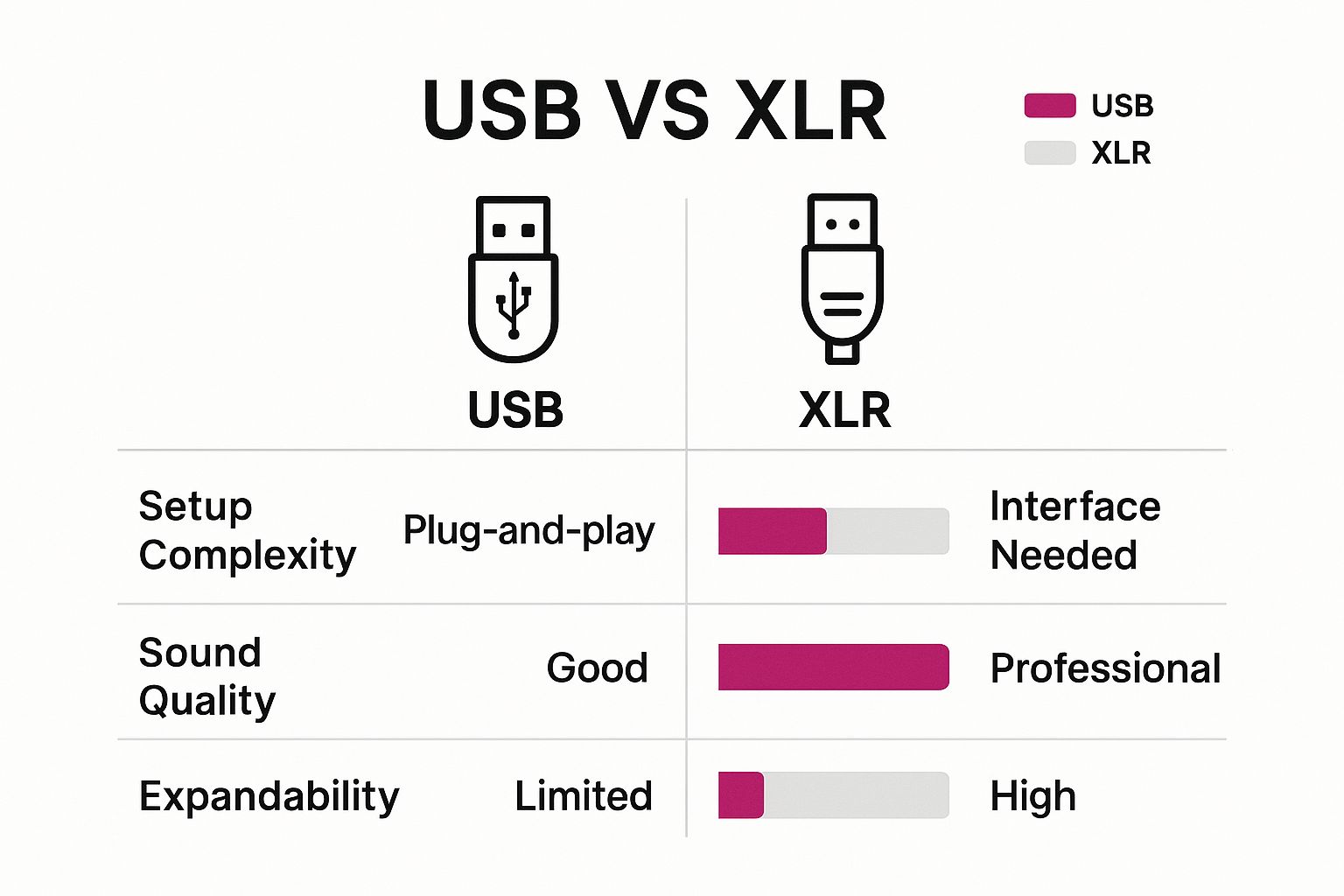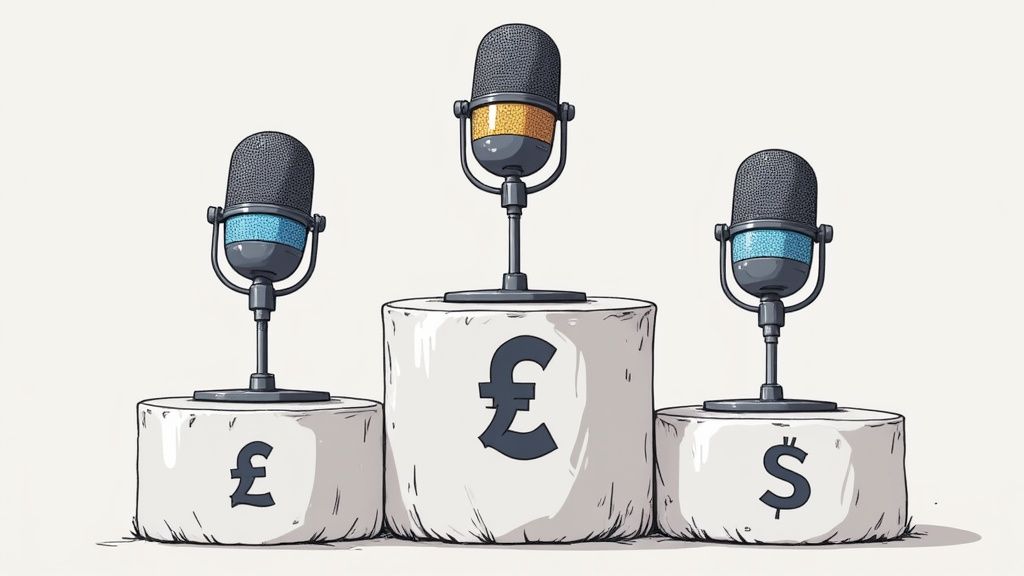Figuring out the best microphones for home recording vocals really boils down to your specific situation and, of course, your budget. If you're just starting out, something like the Audio-Technica AT2020 (around $99) is an absolute workhorse and a fantastic place to begin.
When you feel like you've outgrown that and are ready to step up your quality, the Rode NT1 (about $259) is a natural next step. For those who are getting more serious, maybe even treating their room a bit, the iconic Shure SM7B ($399) delivers that pro, broadcast-quality sound that works wonders, especially in less-than-perfect spaces.

Choosing your first—or next—home recording mic can feel overwhelming. It's easy to get lost in a sea of specs and reviews. But the real goal isn't just to buy a "good" mic; it's to find the right mic for your voice, your room, and the way you work. A microphone that captures every nuance of a soft, breathy folk singer might be a harsh, fizzy nightmare for a loud, aggressive rapper.
This guide gets straight to the point. I’m breaking down my top recommendations based on where you are in your music-making journey.
Before we get into the nitty-gritty details, here’s a quick-glance table to help you see how these popular options stack up. Think of this as your cheat sheet.
This should give you a solid idea of which direction to head in. Each of these has earned its reputation for a reason.
We've seen a massive shift in the market toward making recording more accessible. USB microphones, in particular, have exploded in popularity. In fact, some forecasts show that by 2025, over 70% of the best-selling microphones on major retail sites will be USB models. This just makes it easier than ever for creators to get high-quality sound without needing a ton of extra gear.
The single biggest mistake I see new artists make is thinking an expensive microphone will magically fix a bad-sounding room. Trust me on this: a well-chosen mid-range mic in a space with even basic acoustic treatment will always beat a world-class mic in an echoey, untreated bedroom.
Ultimately, your microphone is just one piece of the puzzle. For a deeper dive into what's currently popular, this guide on the best microphone for recording vocals is a great resource. It also helps to understand the bigger picture of how a pro session works; seeing the process of recording a song in a studio can give you valuable insights to apply to your own setup.

This is the first major fork in the road, and the choice you make here will define the character of your vocal recordings from the jump. Deciding between a condenser and a dynamic mic isn't about which one is "better"—it's about finding the right tool for your voice, your music, and, most importantly, your recording space.
Picture this: you're tracking a soft, acoustic ballad. Your vocal is breathy, full of delicate details that need to be captured perfectly. This is a job for a condenser microphone.
Condensers are built to be incredibly sensitive. They use a lightweight diaphragm that captures sound with stunning accuracy and clarity, making them the go-to choice for pristine, controlled studio environments.
But that sensitivity can be a double-edged sword. A condenser will pick up everything: the echo in your room, the hum of your computer fan, the neighbor's dog barking outside. They really shine when you can give them a quiet, acoustically treated space to work their magic.
The explosion of home studios has made these mics more popular than ever. In fact, condenser microphones now make up over 50% of home studio microphone sales in some key markets. It’s all part of a professional microphone market that was valued at around $1.34 billion in 2025. You can dig into more of the microphone market trends here.
So, you should probably lean toward a condenser if:
A perfect example is the Neumann TLM 102. It’s designed to capture every little subtlety, making it a home studio favorite when clarity is king.
Now, let's flip the script. You’re a rapper with an aggressive delivery or a rock singer who really projects. You’re tracking in your bedroom, which has some natural reverb and isn’t perfectly silent. This is where a dynamic microphone saves the day.
By design, dynamic mics are much less sensitive. They are absolute champs at rejecting background noise, focusing only on what’s right in front of them. This makes them incredibly forgiving if your room isn't acoustically perfect.
The Shure SM7B is the undisputed king of vocal dynamic mics. It was famously used to record Michael Jackson's Thriller and is now a staple for podcasters and rock producers. Why? Because it smooths out harshness and rejects room noise like nothing else.
This built-in durability and noise rejection are why dynamic mics still command a solid 20–25% market share, despite the condenser boom. They solve a very real problem for bedroom producers and home recordists everywhere.
A dynamic mic is probably your best bet if:
Your choice here really sets the stage for your entire workflow. Condensers deliver that pristine, high-fidelity detail but demand a controlled environment. Dynamics, on the other hand, give you a focused, robust sound that just works, almost anywhere you put it.
How your microphone actually talks to your computer is a bigger deal than you might think. It’s a choice that really shapes your whole recording process, and it all boils down to two options: USB or XLR. Each one has a totally different purpose, and picking the right one is all about what you want to accomplish, both right now and down the line.
USB microphones are the very definition of plug-and-play. Everything you need—the mic capsule, the preamp, the analog-to-digital converter—is packed into one single unit. You just plug it into your computer, tell your software to listen to it, and you're off. This is exactly why they've blown up with podcasters, streamers, and musicians who just need to capture an idea fast without getting bogged down in technical details.
Picture this: you're a songwriter in a hotel room with a sudden burst of inspiration, or maybe a voice-over artist working from a laptop on the road. In those moments, you need speed and portability above all else. A USB mic like the USB version of the Audio-Technica AT2020 becomes your best friend. It delivers great quality without forcing you to lug around a separate box of gear. It’s the ultimate all-in-one solution that tears down the barrier to getting high-quality sound at home.
But that beautiful simplicity comes at a price: you can’t really expand your setup. You can pretty much only record with one USB microphone at a time. That makes it a non-starter for multi-person podcasts or tracking a few instruments at once.
This infographic gives you a quick visual breakdown of what sets these two connection types apart.

At the end of the day, USB is all about convenience, while XLR opens the door to a more professional and adaptable recording rig.
There’s a good reason XLR is the industry standard. An XLR mic just sends out a pure analog signal. It needs a separate piece of gear called an audio interface to get that signal into your computer. Yeah, it’s an extra step and an extra cost, but it completely unlocks your sonic potential and gives you incredible flexibility.
An audio interface does more than just connect your mic. It houses much higher-quality preamps and converters than what's crammed inside a typical USB mic. Separating these components gives you a cleaner, more detailed, and genuinely professional sound.
To give you a better sense of the trade-offs, here's a direct comparison of the most important features.
Deciding to go with an XLR setup, even something budget-friendly like a Rode NT1 paired with a Focusrite Scarlett interface, is the smarter long-term play if you're serious about this. It sets you up for future growth.
With an XLR rig, you can:
If your dream is to grow as an artist or producer, starting with XLR from day one lays a foundation you can build on for years to come.

Alright, this is the fun part—actually picking out the gear. Finding the best microphone for your home vocal recordings isn't about draining your bank account. It's really about matching the right tool to what you can spend and what you're trying to create.
I'm going to break down my top picks into three simple tiers. This isn't just a random list of mics; it's a curated guide to help you find the right sonic character for your voice and music, whether you're just laying down a demo or tracking a final, master-ready take.
Starting out absolutely does not mean you have to settle for bad quality. The microphones in this price range are shockingly good, and I guarantee they've been used on countless recordings that sound totally professional.
Audio-Technica AT2020 (XLR/USB): This is pretty much the undisputed king of the entry-level space. The AT2020 is a large-diaphragm condenser that gives you a crisp, clear, and surprisingly balanced sound for the price. It's perfect for capturing all the little details in pop, folk, or R&B vocals.
Shure SM58 (XLR): A legendary dynamic mic that’s built like an absolute tank. It's famous for live shows, but its superpower is rejecting background noise, which makes it a secret weapon for recording aggressive rock vocals or rap in a bedroom that hasn't been acoustically treated. It’s focused, punchy, and incredibly forgiving.
The choice between these two really comes down to your room and your style. Go for the AT2020 if you want that high-end detail, but grab the SM58 if you need to tame a noisy environment.
This is the sweet spot. It's where you see a massive jump in quality without getting into those astronomical prices. Mics in the $150-$400 range often become lifelong workhorses for home and project studios.
The main event in this category is a classic showdown between two microphone philosophies.
On one side, you have the Rode NT1. This XLR condenser has become an industry standard because of its exceptionally low self-noise and bright, detailed sound. It excels at capturing every single nuance of a vocal performance, making it a go-to for clean, modern pop and singer-songwriter tracks.
The Rode NT1 is a perfect example of why traditional XLR condenser mics are still dominant in serious home studios. Even with the convenience of USB, over 60% of semi-pro users prefer XLR for critical vocal recordings because of the superior sound and versatility. You can dig deeper into why XLR mics are an enduring standard over on Soundref.
On the other side is the Shure SM7B. This iconic dynamic microphone is the sound of countless hit records and podcasts. It has a warm, rich, and smooth character that tames harsh high frequencies and minimizes room reflections. That makes it ideal for everything from aggressive rap to intimate, broadcast-quality voice-overs.
Here's a quick look at how they stack up:
When your budget climbs past $400, you're stepping into the territory of professional-grade tools that deliver truly uncompromising audio fidelity. These mics offer a level of clarity, depth, and character that can elevate a good performance into a great one.
Neumann TLM 102/103: Neumann is legendary for a reason. The TLM series brings that classic, high-end condenser sound into a more accessible price point. These mics give you a polished, radio-ready sound right out of the box, with a gentle presence boost that helps vocals cut through a dense mix without any effort.
Electro-Voice RE20: Another broadcast and studio legend, the RE20 is a dynamic mic known for its minimal proximity effect. What that means is you can get right up on the mic for an intimate sound without the low-end getting all boomy or muddy. This makes it a huge favorite for rap and spoken word.
Unboxing one of the best microphones for home recording vocals is a great feeling. But let's be real—the gear alone won't get you a professional sound. The magic truly happens when you pair that shiny new mic with smart recording techniques.
And the good news? You don't need a million-dollar studio to hear a massive leap in quality.
It all starts with mastering your microphone placement. A lot of beginners make the mistake of singing directly into the front of the pop filter. The "sweet spot," however, is often slightly off-axis.
Try positioning the mic so you're singing just past the capsule, not straight into it. This one simple adjustment can dramatically cut down on harsh sibilance and plosives—those aggressive "p" and "b" sounds—without killing your vocal clarity.
Every home studio has a secret weapon you might be overlooking: the closet.
Recording vocals inside a walk-in closet packed with clothes is a classic home studio trick for a reason. All that fabric acts as a natural acoustic absorber. It absolutely kills the echo and boxy reflections that make a vocal sound cheap and amateurish.
A common misconception is that a better microphone will fix a bad-sounding room. The opposite is true: a sensitive condenser mic will only highlight the echo and noise more clearly. Your first step should always be controlling your environment, not buying more gear.
Beyond just the mic, a truly pro sound comes from a thoughtful approach to your entire setup. If you're looking to build out your space from the ground up, this comprehensive home recording studio setup guide is an amazing resource for planning everything from interfaces to monitors.
Before you even think about hitting that red button, run through a quick checklist. These small habits are what separate clean, usable recordings from frustrating sessions that end with you scrapping an otherwise perfect take.
Once your raw vocal is captured cleanly, you move on to the mixing stage. Learning how to EQ vocals is a fundamental skill that will help your voice sit perfectly in the track, adding that final layer of polish and clarity.
Alright, so you’ve picked out a great mic and it's arrived at your door. Awesome. But getting the gear unboxed is one thing—actually getting a great sound out of it is a whole other ballgame. Let's dig into some of the most common questions and hurdles that pop up once you start recording for real.
Yes. Full stop. Don’t even think of them as optional accessories; they're as essential as the microphone cable.
A pop filter is your first line of defense against plosives. Those are the aggressive bursts of air from 'p' and 'b' sounds that slam into the microphone's diaphragm and create a distorted, thumpy mess. A pop filter diffuses that air before it can ruin a perfect take.
The shock mount is just as crucial. It's a clever suspension system that isolates your mic from any vibrations coming up the stand. Without one, something as simple as tapping your foot or bumping the stand can create a low-end rumble in your recording that’s a nightmare to clean up later.
If you went with an XLR mic (which you should for serious recording), the audio interface is the non-negotiable bridge to your computer. It juggles a few critical jobs you can't do without.
Good news is, you don't have to break the bank. Entry-level boxes like the Focusrite Scarlett series are fantastic, reliable, and the go-to for countless home studios for a reason.
Here's a hard truth many learn too late: A high-end microphone won't fix a bad-sounding room. It will just capture all the echo and flutter with painful accuracy. The real fix is always treating your space, even if it’s just with a few blankets or a closet full of clothes.
Nope. In fact, it’ll probably make it worse. This is especially true with those sensitive condenser mics we love for vocals. They are designed to capture every little detail in a room, and that includes all the nasty sound reflections bouncing off your walls.
The only real solution is acoustic treatment. You don’t need to go build a pro-level vocal booth. Simple, DIY hacks can work wonders. Recording in a walk-in closet packed with clothes is a classic trick because all that fabric absorbs sound reflections. Another old-school method is hanging heavy blankets or moving blankets around your recording spot.
Once you nail that clean, dry vocal take, the next step is making it shine in the mix. Our guide on how to mix vocals is the perfect place to start.
You can, but it’s rarely the best tool for the job.
That trusty Shure SM58 you use on stage is a dynamic mic. It's built like a tank to survive gigs, and it’s designed to reject feedback from loud stage monitors. It’s brilliant at that.
But in the studio, that same design means it lacks the sensitivity and high-frequency detail of a good condenser. For most vocal styles, a dedicated studio condenser will deliver a far clearer, more nuanced, and professional-sounding vocal. The exception? If you're recording screaming rock vocals or you're in a really noisy, untreated room, a dynamic mic might actually be a better choice to tame the chaos.
Ready to make sure your final track sounds incredible everywhere, especially in the car? CarMaster uses specialized AI to deliver masters optimized for automotive sound systems, ensuring your vocals and bass come through clean and powerful. Get a free, instant preview and hear the difference for yourself.